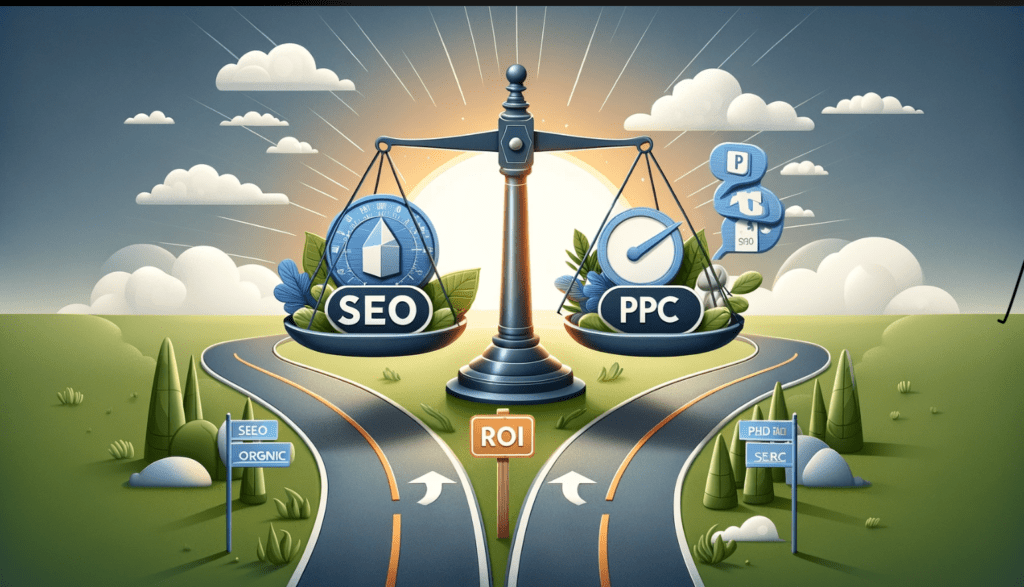SEO vs PPC: Long term growth vs immediate results
The digital marketing landscape is continuously evolving, with businesses striving to find the sweet spot between organic search (SEO) and paid search (PPC) for maximum return on investment (ROI). In this blog, we’ll delve into the intricacies of SEO versus PPC, backed by real-world case studies and actionable tips. Did you know that businesses make an average of $2 in income for every $1 they spend in Google Ads? This stat alone highlights the potential of a well-balanced digital marketing strategy.
Deep Dive into Key Elements
SEO versus PPC

- SEO: It’s about building a solid foundation for your online presence. Over time, SEO helps in developing brand authority and trust with search engines, which translates to higher rankings and organic traffic. This long-term value is crucial for sustainable business growth.
- PPC: Offers the advantage of quick visibility. It’s ideal for targeting specific demographics or promoting time-sensitive offers. PPC provides immediate feedback on campaign effectiveness, allowing for rapid adjustments.
Best Practices:
- SEO:
- Consistent and High-Quality Content: Regularly publishing valuable, relevant content that addresses user queries and needs.
- Keyword Optimization: Identifying and integrating relevant keywords without overstuffing. This includes long-tail keywords which are less competitive and more specific.
- On-Page Optimization: Ensuring that all elements on your webpage, like title tags, meta descriptions, and image alt texts, are optimized for search engines.
- Technical SEO: Focus on improving site speed, mobile-friendliness, and secure browsing (HTTPS).
- User Experience: Enhancing the website’s navigation, structure, and internal linking to improve user engagement and reduce bounce rates.
- PPC:
- Targeted Ad Copy: Crafting compelling ad copy that resonates with the target audience, including clear call-to-actions.
- Audience Segmentation: Creating different campaigns for different segments of your audience based on demographics, interests, or behaviors.
- Keyword Bidding Strategies: Managing bids on keywords effectively, focusing on both high and low-competition keywords.
- Landing Page Optimization: Ensuring that the landing page is relevant, user-friendly, and optimized for conversions.
- Continuous Testing and Optimization: Regularly testing different elements of your campaigns like ad copy, keywords, and bidding strategies to find what works best.

Return on Investment (ROI)
Importance: ROI is the metric that ultimately determines the success of your digital marketing efforts. It helps in understanding the efficiency of your investment in SEO and PPC campaigns. Maximizing ROI ensures that you are not just driving traffic or gaining visibility, but also effectively converting these into tangible business outcomes like sales or leads.
Strategies:
- Cost-Per-Click Analysis (PPC): Regularly review the cost-per-click of your ads and compare it against the conversion rate and customer lifetime value.
- Long-Term Traffic Analysis (SEO): Evaluate the organic traffic trends and how they correlate with conversions over time.
- Balanced Approach: A combination of both SEO and PPC, leveraging the immediate results of PPC with the sustainable growth of SEO.
- Performance Tracking: Utilize tools like Google Analytics to track and measure performance metrics, adjusting strategies based on data-driven insights.
Marketing Strategies
Importance: Different stages of the customer journey require different marketing approaches. An integrated strategy using both SEO and PPC allows you to cater to customers at each stage, from building awareness to driving conversions.
Best Practices:
- SEO for Building Awareness and Credibility:
- Focus on creating informative content that addresses the top of the funnel queries.
- Enhance local SEO strategies to build community trust and visibility.
- PPC for Conversion and Targeted Campaigns:
- Use PPC to target potential customers who are at the decision-making stage with specific product or service ads.
- Implement retargeting campaigns to capture the interest of users who have previously interacted with your brand.
- Cross-Channel Synergy:
- Ensure consistency in messaging and branding across both SEO and PPC.
- Use insights from PPC campaign data to inform your SEO strategy and vice versa.
Actionable Tips for Maximizing SEO and PPC ROI
1. Audit Your Current Strategy: Regularly Evaluate Your SEO and PPC Performance
- Frequency and Depth: Conduct comprehensive audits of your SEO and PPC strategies at least quarterly. Assess keyword rankings, ad performance, content relevance, and link profiles.
- Competitive Analysis: Benchmark your performance against competitors. Identify areas where they excel and opportunities for your strategy to improve.
- Tool Utilization: Use tools like Google Analytics, SEMrush, or Moz for deeper insights into traffic patterns, bounce rates, and conversion metrics.
- Feedback Loop: Incorporate feedback from these audits into your ongoing strategy, making necessary adjustments for optimization.
2. Customer-Centric Keyword Research: Understand Your Audience’s Search Intent
- Search Intent Classification: Identify keywords based on the user’s intent – informational, navigational, transactional, or commercial.
- User Personas: Develop detailed user personas to better understand the needs and search behaviors of your target audience.
- Long-Tail Keywords: Focus on long-tail keywords, which are less competitive and more specific to user intent.
- Ongoing Research: Regularly update your keyword strategy to align with evolving user behaviors and industry trends.
3. Optimize Landing Pages: Ensure a Seamless User Experience
- Relevance and Clarity: Make sure your landing pages directly address the user’s query or the ad’s promise.
- Loading Speed: Optimize for speed; slow-loading pages can significantly increase bounce rates.
- Call-to-Action (CTA): Include clear, compelling CTAs that guide users towards the desired action.
- Mobile Optimization: Ensure your landing pages are fully responsive and provide a seamless experience on mobile devices.
4. Leverage Analytics: Make Data-Driven Decisions
- Key Metrics: Track important metrics such as click-through rates (CTR), conversion rates, cost per acquisition (CPA), and organic traffic growth.
- User Behavior Analysis: Analyze how users interact with your site to identify areas for improvement.
- ROI Calculation: Regularly calculate the ROI of both SEO and PPC campaigns to assess their effectiveness and adjust budgets accordingly.
5. Continuously Test and Adapt: Stay Flexible and Responsive to Market Changes
- A/B Testing: Regularly conduct A/B testing for your ads, landing pages, and even content strategies to determine what works best.
- Adapt to Trends: Stay updated with search engine algorithms and digital marketing trends, adapting your strategies to these changes.
- Feedback Incorporation: Use customer feedback and market research to refine your approach continually.
6. Educate Yourself: Keep Up with the Latest Trends in Digital Marketing
- Continuous Learning: Engage in webinars, online courses, and attend industry conferences to stay informed.
- Networking: Join digital marketing communities and forums to exchange ideas and learn from peers.
- Industry Publications: Regularly read industry blogs and publications for the latest news and best practices.
7. Seek Professional Advice: Don’t Hesitate to Consult Experts for Complex Campaigns
- Expert Consultation: For complex campaigns or if you’re struggling with certain aspects of your strategy, seeking advice from marketing experts can provide valuable insights.
- Agency Partnership: Consider partnering with a digital marketing agency for specialized campaigns or to supplement your in-house expertise.
- Customized Solutions: Experts can provide tailored advice and solutions that align with your specific business goals and challenges.
Frequently Asked Questions (FAQ) for
Q1: What is the fundamental difference between SEO and PPC?
A1: SEO (Search Engine Optimization) focuses on improving your site to increase its visibility in organic search results. PPC (Pay-Per-Click), on the other hand, involves paying for advertising space in search results. While SEO is about building long-term traffic organically, PPC offers immediate visibility and results.
Q2: How do I know when to use SEO or PPC?
A2: The choice depends on your goals and timeline. Use SEO for long-term growth, brand credibility, and sustainable traffic. Opt for PPC when you need immediate visibility, targeting specific demographics or keywords for a short-term campaign.
Q3: Can SEO and PPC work together?
A3: Absolutely! A combined approach often yields the best results. While SEO builds a solid foundation and credibility, PPC can fill in gaps for specific campaigns or target audiences, offering a comprehensive digital marketing strategy.
Q4: Is PPC more expensive than SEO?
A4: PPC can be more costly upfront due to its pay-per-click nature, whereas SEO is more about time and resource investment. The cost-effectiveness of each depends on various factors like industry competition, keyword difficulty, and campaign management.
Q5: How long does it take to see results from SEO and PPC?
A5: PPC often shows immediate results as soon as your ads go live. SEO, in contrast, is a long-term strategy, typically taking several months to a year to show significant results.
Q6: Can small businesses compete with larger ones in SEO and PPC?
A6: Yes, small businesses can effectively compete by targeting niche keywords, local SEO strategies, and carefully managed PPC campaigns with smaller budgets.

